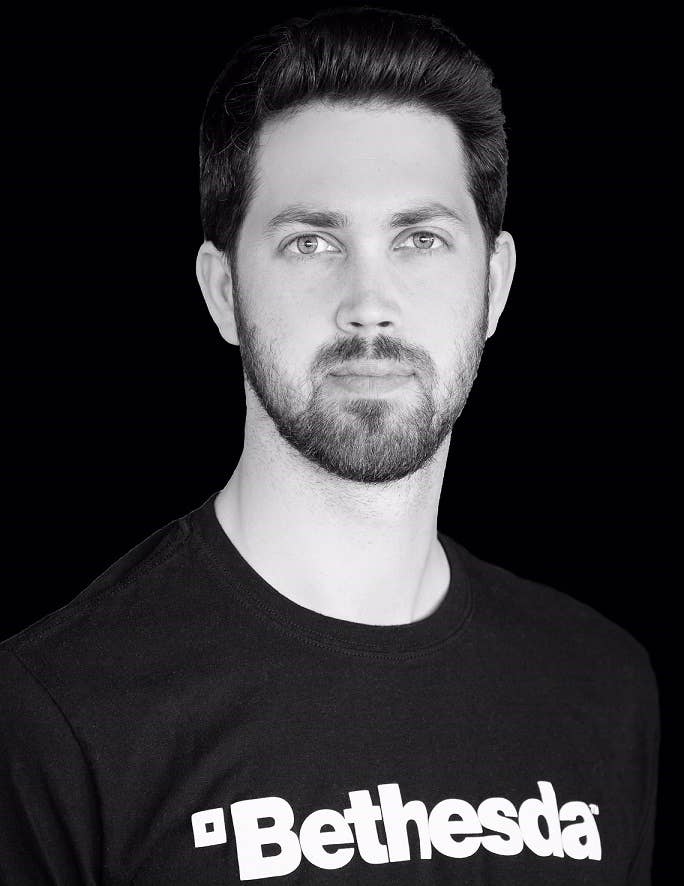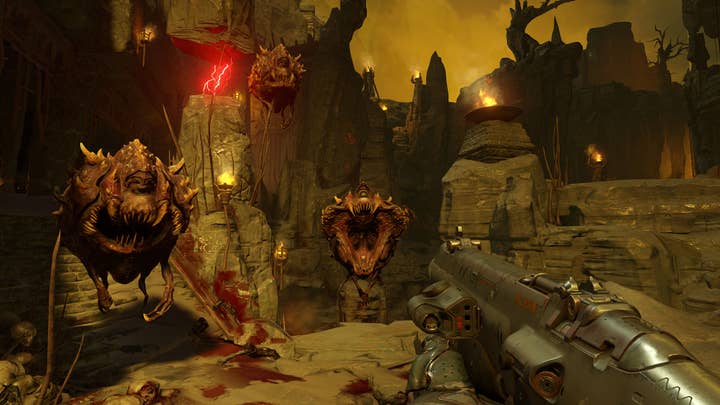Bethesda unveils Orion game streaming tech
Robert Duffy and James Altman discuss the details of the company's new engine optimization SDK that works with any streaming service
Bethesda is getting into on-demand streaming, but it's coming at the business from a new angle.
In a pre-E3 briefing, the company hosts us along with journalists from two other outlets at its Rockville, Maryland headquarters to show off Orion, a new technology it says will allow developers to make their games perform better through on-demand streaming no matter the service provider.
Orion is essentially a collection of software techniques that Bethesda is putting together in a unified software development kit. The company says that by incorporating them into any game engine, developers can significantly reduce a title's latency, bandwidth requirements, and required cloud computing power in a streaming environment. Orion is the product of id Software's id Tech team in Dallas and Frankfurt, and Bethesda director of publishing operations James Altman says the group has been working on streaming for years.
Altman says there are two primary challenges for on-demand game streaming: latency and computing power.

To date, on-demand streaming companies have been addressing the latency issue as a hardware problem, he says, attempting to "brute force" the solution by building out infrastructure to reduce customers' distance to cloud servers (and thus cut down on latency) or building optimized video encoding and compression into the hardware to reduce bandwidth required.
The problem, according to Altman, is that these sort of efforts to improve the streaming experience only begin after the game running on a remote server has already rendered any given frame.
"We believed we could achieve significant savings and significant improvements and enhancements to the player experience by starting our optimizations at the very earliest literal possible point, which is on the game engine level," Altman says.
Altman says that streaming services have indicated users would need a minimum bandwidth of 25 Mbps for an acceptable experience, but added that the average US household only has a connection speed of 18 Mbps. (Altman does not specify which streaming services give a 25 Mbps guideline. PlayStation Now requires a 5-12 Mbps connection, although it is limited to a 720p resolution. Google Stadia recommends a minimum of 10 Mbps for streaming in 720p and 35 Mbps for streaming in 4K.)
As for the computing power problem, Altman said streaming games just requires more horsepower than streaming other forms of media, "partly because of rendering and partly because of compression." More power draw means it costs more money to run a game, particularly at the scale anticipated for the new wave of streaming services.

id Software chief technology officer Robert Duffy shows off Orion by playing the 2016 version of Doom on a MacBook, streaming in 1080p from a data center in Ohio. He says that generally when using the tech, he's able to feel a little latency when using a keyboard and mouse control scheme, but a controller set up "feels fine after a minute or two."
Duffy runs through a level with and without one key Orion technique turned on to compare the performance difference.
An on-screen overlay shows a number of stats, including the overall bandwidth being used by the game, the time the GPU in the cloud spends rendering each frame, the time spent compressing/encoding a frame, and GPU and video engine utilization percentages that reflect how much power is needed to run the game.
From our observations during the demo, turning the technique on reduces bandwidth use from 27-35 Mbps to 20-23 Mbps, while the Cloud GPU rendering time drops from 1.3 milliseconds per frame to 1 millisecond per frame. Encode time is reduced from 5.7 milliseconds per frame to 4.3 milliseconds per frame. Those reductions may sound modest, but in a game that runs at 60 frames per second, Duffy says they can add up to a big difference for how a game runs for the player. They can also make streaming easier for users whose internet service providers have bandwidth caps or overage charges.
Our observations are made on the fly during a single demo run, but a slide Bethesda has prepared a slide for the presentation states that the average bandwidth used during a 10-minute gameplay test with the Orion tech off was 23.43 Mbps, while turning it on drops that to 13.67 Mbps. Likewise, the company says the technique provides encode time efficiencies of "up to 30%" compared with the roughly 25% savings that we note during our demo.

Orion could also significantly cut costs for service providers as a result of the lessened power draw, Duffy says. We see the GPU utilization percentage go from a range of 60- 64% without the technique on to 55% with it on, while video engine utilization drops from 17.5% to 15%. The benefits for a single session of play may be negligible, but for operations running at scale, those savings can add up to something significant.
"There are optimizations that will benefit any game, any game engine, particularly the most difficult ones. But even the simpler ones will have benefits that we'll see"
James Altman
Duffy also shows off an Orion-enabled stream of Doom running at 4K. It is in less-than-ideal conditions, as the game was running on a server more than 2,000 miles away in California that couldn't actually handle Doom in 4K at 60 frames per second. The demo streams at about 36 frames per second, with Duffy noting that a live 4K stream might require an internet connection of 50-70 Mbps for crystal clear video.
The journalists are invited to try out Doom streaming with the one technique turned on either on the MacBook or on a pair of iPhones with controller attachments, one streaming the game from Virginia and the other from Frankfurt, Germany.
As for the technique being demonstrated, the patent (which was filed for in April 2018 and granted in April 2019) covers a method of handling post-processing effects, giving simulated film grain as one such example. The patent states that such effects can be time-consuming for encoders to process, so the idea is to turn those effects off at the engine level, stream the image, and then have the user's gaming device apply the post-processing effects at the other end.
This is just one part of the Orion SDK, but it is one Altman says should be effective with "just about any modern AAA game." Some of the other techniques involve predictive elements. Duffy gives an example where an explosion goes off, so the game comparisons between frames during the encoding process because it's quicker to create a new key frame. It doesn't save much on its own, he admits, but it does add up.
Orion is in active development and currently has four patented techniques implemented, with another two on the way, and a number of others with patent applications in the works.
"As we're working through these [patents] and implementing them, we're finding new ways that we think we can really enhance streaming at the game level and make it better for consumers," Duffy says, suggesting that in the long run, Orion could encompass 12-20 different processes.
"I think the usage patterns in our society are kind of demanding this," he says. "You want your movies on demand. You want your music on demand. You want your fast food on demand"
Robert Duffy
Altman adds, "There are optimizations that will benefit any game, any game engine, particularly the most difficult ones. But even the simpler ones will have benefits that we'll see."
Integrating third-party technology isn't always the smoothest endeavor, but Duffy says with Orion it "should be very straight-forward."
"Some of the techniques go a little deeper into the actual game code and things like that, but with this particular technique, the integration is very simple," he says, adding, "We don't believe this is months and months of work. We believe it's effectively a very small percentage of our overall development cycle."
On top of that, Altman says Orion has no drawbacks if it's incorporated into a game that isn't streamed.
Streaming is the latest in a long line of speculatively disruptive forces in gaming. And while these technologies don't always pan out, Duffy is confident streaming will be "a dominant form of distribution" eventually.
"I think the usage patterns in our society are kind of demanding this," he says. "You want your movies on demand. You want your music on demand. You want your fast food on demand. And you also want to be experience games not only on demand, but anywhere you are, I think. Look at games like Fortnite and that is being played on every device everywhere. I personally think game streaming is going to be big. I have no idea when or if it takes over the traditional distribution.
"There are a lot of consumer benefits: Play now, no patches, no cheating. And there are publisher benefits: no digital rights management problems, no piracy. There are upsides to it for everybody."
There are still a number of unknowns around Orion. For one, Bethesda is not talking about how the business model will work, nor about strategic discussions they might have had with partners (although it's worth noting Bethesda has committed five games to Google Stadia, more than any publisher save Ubisoft). Altman says the company isn't planning to launch its own streaming service, but acknowledges it has Bethesda.net as a direct-to-consumer portal if it ever decided to offer its own games on a streaming basis.
For those looking to try Orion out for themselves, Bethesda plans to run a larger-scale public tech test of Orion later this year, with testers able to stream the game on iOS devices.
Disclosure: Bethesda paid for our travel.
